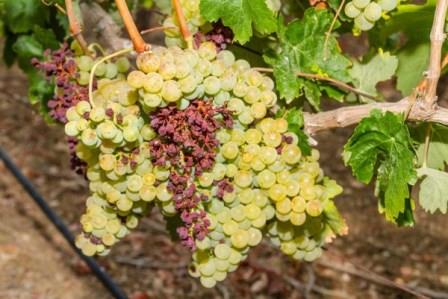 Unfortunately, grapes have many diseases, and you need to have time to detect and treat the diseased plant in time so that the entire crop does not die. We will describe the main diseases of grapes with a photo, see the description and recommendations on how to treat.
Unfortunately, grapes have many diseases, and you need to have time to detect and treat the diseased plant in time so that the entire crop does not die. We will describe the main diseases of grapes with a photo, see the description and recommendations on how to treat.
It is also important - preventive measures, without them it is very difficult to get a healthy crop, it is well known that it is much easier to prevent a disease than to then make efforts and spend time looking for effective treatments.
Content
Mildew
This is the most dangerous and most common disease of vineyards. It is also called "downy mildew", this fungal disease affects all green parts of the bush and the crop. If measures are not taken in time, then it can bring significant damage to the entire plantation. The appearance of the disease is immediately determined by the leaves, if oil yellow spots appear on them - sound the alarm, this is mildew. If you look at the back of the sheet, you can notice a white coating that resembles flour.
The infection spreads quickly at a slightly moist and warm temperature, affecting the leaves, stems, and then the fruits. Bunches of grapes acquire a purple hue, berries shrink and become unsuitable for consumption. The leaves gradually dry and fall, the affected green parts lose their stability, the top of the bush dries out. In some cases, the entire bush may die.
Read more: cucumbers in a barrel, growing Ganichkina.
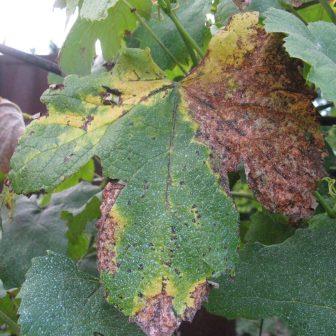
The cause of the disease
Mildew is a fungal disease, its spores winter in fallen leaves, are resistant to cold. With the appearance of heat and moisture, mildew quickly develops, a germ tube forms, on which there is one sporangium. With wind or rain, he falls on a grape bush and throws out more than 60 zoospores, which cause infection of the plant.
The disease spreads quickly if the temperature is above 12 degrees and there is a lot of humidity in the air. If there is no suitable temperature above 30 degrees and there is no moisture, the disease does not progress. Zoospores will wait for favorable weather and attack the vineyard at the right time. The fungus is then fixed on the host plant and forms the reproductive organs, the so-called sporangi, which are visible to the naked eye on the back of the leaf in the form of a white gun. With the slightest breath of wind, they easily fly away, and if the humidity is high, they immediately begin to infect other healthy vine bushes.
How to treat “false flour dew"
European grape varieties are considered the most easily amenable to this disease, and American varieties are the most resistant to the disease. If grapes are sick with a fungal disease, then all methods of treatment will generally be ineffective. Therefore, in order to protect the vineyards, prevention is needed that will not allow or at least reduce the risk of the disease.
Prevention
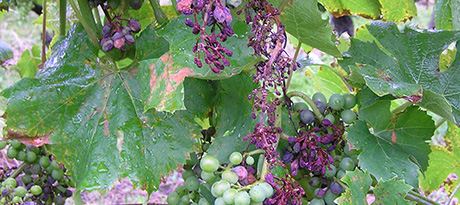
• treatment of plants with chemicals before and after flowering. Helps especially well plant growth product, which not only improves the crop, but also prevents pathogenic flora;
• cleaning and plowing of fallen leaves in autumn and spring, which will destroy the bulk of the embryos;
• high aisles, which are well ventilated, thereby reducing the spread of infection;
• garter vines;
• weeding weeds.
Still interesting for gardeners: growing potatoes wisely without weeding and hilling.
Treatment Methods and Preparations
Antifungal spraying of young vineyards every 10 days. With the advent of heat, around mid-June, spraying should be done every seven days. Removing diseased branches and leaves that need to be burned. Infected bushes are sprayed with pesticides, antifungal drugs must contain copper and zinc.
One of the most effective anti-mildew remedies is a solution of Bordeaux fluid. But, you need to consider that the consistency of the solution should not exceed 3%, otherwise you can destroy, burn, the surface of the leaves. The vitriol used for spraying should be of high quality, not contain any other impurities, its color should be bright blue. The solution is prepared with lime, which is extinguished during the process, so the tool will stick better to the leaves, which will provide the best treatment and prevention of the vineyard.
Since this drug is easily washed off by rain, treatment and prevention are carried out in four stages:
1. After trimming and garter in the spring, moreover, not only the bush is sprayed, but also the ground around it.
2. After flowering.
3 and 4. During the fruiting period with an interval of 10-14 days.
Oidium or powdery mildew
Another fairly common disease, especially in the hot parts of our country. It is in warm weather that it actively develops, affects leaves, berries and shoots, which are covered with a gray coating. Infected shoots and leaves dry and fall over time, the berries burst and dry. It affects almost all grape varieties, including hybrid ones.
If shoots appear on the bush that noticeably lag behind in growth, their leaves are twisted and curly, covered with a coating similar to gray dust - this is real powdery mildew.
Causes of the disease
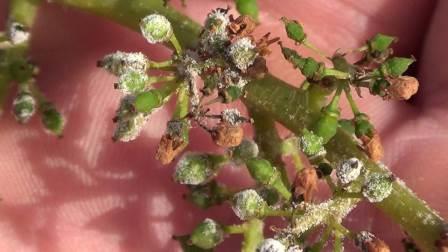
The causative agent of Oidium hibernates in the eyes of an infected plant. In the spring, when the first shoots appear, the bush is already infected, and with little air humidity and warm temperature, the infection develops rapidly. In France in 1852 and over the course of several years, this disease caused enormous damage to viticulture. Hundreds of dozens of plantations were destroyed. And only after it was discovered that it can be treated with sulfur, the disease was stopped.
Prevention and control of powdery mildew
• Well-ventilated vineyards are the best prevention against fungal diseases.
• Plant varieties with high disease resistance.
• Break out diseased branches and leaflets.
• If last year the defeat was large, then it is best to treat the bushes after the first shoots appear.
The most effective method against powdery mildew is considered to be preparations containing sulfur. Spraying is carried out at the first signs of the disease, and if the disease progresses, then repeated spraying is carried out every one and a half weeks.
Read more: DIY garden not like everyone else, interesting ideas.
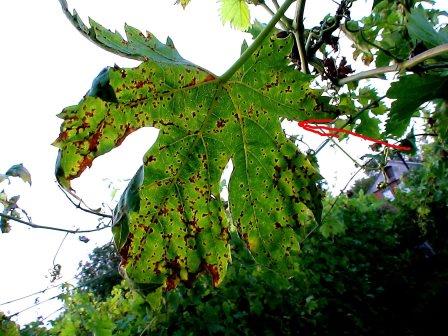
- If only small areas of gray plaque appeared on clusters, dusting should be carried out with a 2% suspension of colloidal sulfur. But after this, washing the berries is necessary. The last sulfur spraying of the vineyards is carried out two months before the harvest.
- Sulfur treatment should be done in the early morning or late evening. In the heat of the day, you can burn berries and leaves.
- During the fruiting period, it is better not to use chemicals that can harm ripe grapes. The plant can be treated with a solution of potassium permanganate, 10 g of powder per 20 liters of water.
- You can prepare an infusion: in 7 liters of water, half a bucket of ash is bred, insisted for a day and diluted with water before spraying, in a one to one ratio. To better stick to the solution, add 100 g of grated green soap.
- You can buy ready-made preparations that will help fight powdery mildew: Talendo, Karatan after flowering are very good for prevention, but Tiovit Jet can be used even while pouring berries. Let us consider further the diseases of grapes, the photo and its treatment.
Shoots drying
This is not an infectious disease, but can ruin a huge planting of grapes. Its characteristic is this: it develops rapidly, striking shoots, covering them with brown and black spots. It may appear from too much rainfall or, conversely, from a lack of moisture.
The plant is sprayed with a solution of 3% sodium sulfate, for varieties sensitive to chemical preparations, complex fertilizers are applied.
Alternariosis
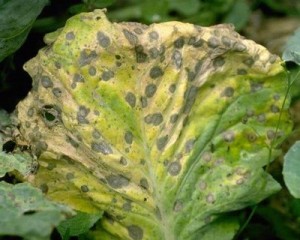
Fungal disease of grape leaves. First, light specks appear on the leaves, then they darken and the leaf turns completely black. The disease passes to the berries, they become covered with plaque, become wrinkled and lose their taste.
How to fight
You need to start the fight immediately, as soon as the disease appeared on several leaves. Remove bark, remove diseased leaves and dead shoots. The plant is treated with Bordeaux liquid at the beginning of the growing season. Then once a week, if necessary. And then we will consider grape diseases, photos and descriptions, treatments and its berries.
Armillariosis
Fungal disease, also called root rot. The roots become soft, friable, the leaves dry out and gradually the plant dies. There is no treatment as such, a dead bush is dug up, the soil is treated with fungicides containing copper. Experienced gardeners recommend not to plant grape bushes on diseased land for a year.
Read more: garden, kitchen garden, cottage, all the brightest and most interesting do-it-yourself.
Grape Itch or Mite Felt
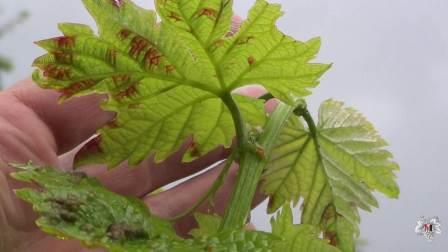
If you are interested in grape diseases, photos, and how to treat a leaf with pimples, read on, this is itchy. Mostly affects grape leaves, from a puncture of a tick in the leaf pimples with a bulge are formed. On the back side of the leaf, a tubercle forms, covered with a light fluff, which then becomes dark brown. In red grape varieties, as the ailment increases, the leaves turn red. The spots on the leaves increase, join together, the leaf curls and sags.
In some cases, the disease can stop at the defeat of the leaves of the lower tier. If the weather is rainy, then ticks are spread on grapes, the berries are covered with felt and become unusable. The insect multiplies very quickly and also is a carrier of more serious and dangerous diseases for grapes.
How to fight
Sulfur preparations or conventional acaracid ones are used to combat felt mites. Takee also uses chemicals that do not harm bees and humans: Tevit, Fufanon, Neoron, and others.
Mealybugs and scale insects
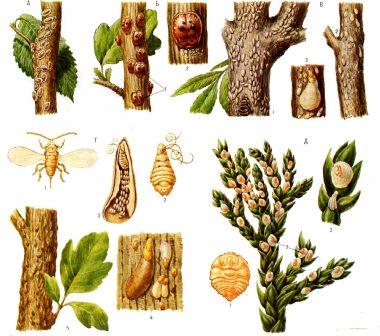
These pests stick to the bark of the vine, feed on its juice. From this, the plant weakens, yield decreases. Fungi form on the habitat of insects, which lead to more serious diseases. Insects winter in the bark of shoots, and in the spring go outside. If you grow grapes, leaf diseases and treatments are of primary interest to you, see MORE: grape diseases, photos and how to treat.
How to fight
Thoroughly spray the bush under high pressure so that the drug can penetrate deep beneath the bark and destroy the pests. Spraying is carried out in the spring, before the first buds open.
We told you what diseases of grapes exist, photos showed, and recommended to treat a leaf. Have a good harvest!




 Non-covering winter-hardy grape varieties for Moscow region
Non-covering winter-hardy grape varieties for Moscow region How to keep the vine in winter
How to keep the vine in winter When can I transfer grapes to another place in the fall
When can I transfer grapes to another place in the fall How to cover and prepare grapes for the winter in the suburbs
How to cover and prepare grapes for the winter in the suburbs
Yuri
thank you Your advice is very helpful.
Oleg
Help make a diagnosis !!! Lots of brown dots all over the leaf. And like most along the veins of the leaf. And only on the upper leaves. The lower ones seem to be normal. Appeared recently, in the summer it was not .. Variety Isabella. Thank you in advance.